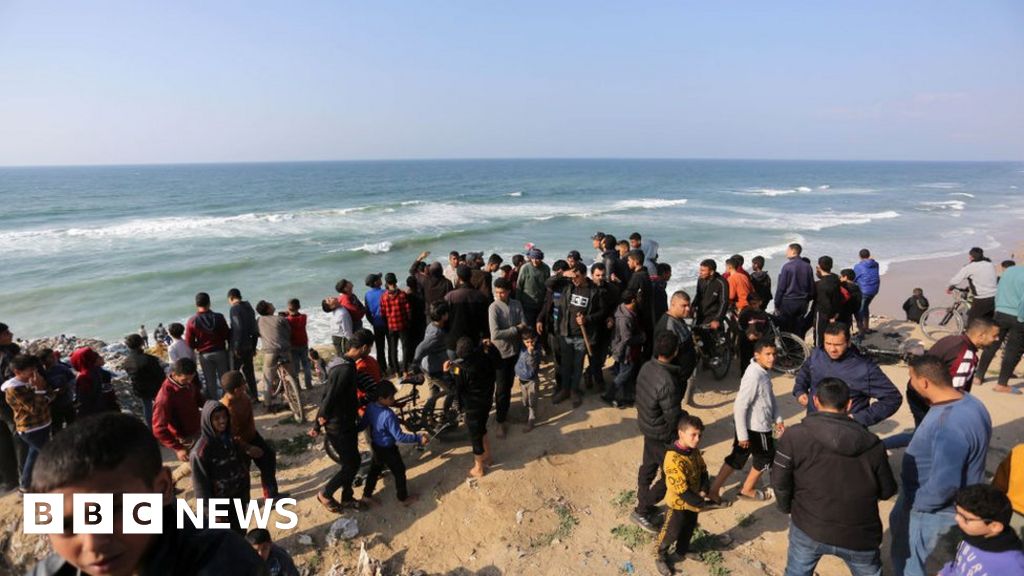Image source, Getty Images
Ursula von der Leyen says the sea corridor to Gaza could start this weekend
European Commission President Ursula von der Leyen said that the sea corridor to Gaza could start operating at the end of this week to boost aid to the Strip.
This comes a day after President Biden announced that the United States plans to build a floating dock on the Gaza coast.
But the Pentagon said Friday that it could take up to 60 days to build.
The United Nations says a quarter of Gaza's population is on the brink of famine and children are starving to death there.
Getting aid into the Gaza Strip was difficult and dangerous.
The United States and other countries have resorted to airdrops of aid as conditions worsen, but relief organizations say this tactic is a last resort and cannot meet the growing needs.
Speaking in Cyprus, Ms von der Leyen said Gaza was “facing a humanitarian catastrophe” and that the sea corridor would enable the delivery of large amounts of additional aid.
A joint statement from the European Commission, Cyprus, the US, the UK and the UAE said operating a sea corridor would be “complex” and they would continue to pressure Israel to expand aid delivery by land, facilitate more roads and open additional crossings.
British Foreign Secretary David Cameron said: “We continue to urge Israel to allow more trucks to enter Gaza as the fastest way to deliver aid to those who need it.”
Israel welcomed the initiative and urged other countries to join it.
A Foreign Ministry spokesman said the aid would be delivered after security checks “in accordance with Israeli standards.”
However, the head of Refugees International told the BBC that while the sea route was welcome, it was unlikely to be able to deliver anything like enough food.
“It does not appear that this will be anywhere near the scale needed to reverse the famine that Gaza is experiencing now,” Jeremy Konyndyk said.
Israel denies obstructing the entry of aid into Gaza and accuses relief organizations of failing to distribute it.
The operation – which he said would not include US forces on the ground in Gaza – would enable large ships to deliver food, water, medicine and temporary shelters.
The US Army said on Friday that the port could take up to 60 days to complete, and that it could take up to 1,000 personnel to build, but none of them would go ashore.
The Pentagon says the United States ultimately aims to provide two million meals a day to Gaza residents.
Biden said the dock would make a “huge difference” in the amount of aid reaching Gaza, but added that Israel must “do our part” by allowing more aid into the Strip and “ensuring that humanitarian workers are not arrested.” “In the crossfire.”
But an independent UN expert said on Friday at a press conference in Geneva that it was “ridiculous” for a close ally of Israel to resort to such measures.
Michael Fakhri, Special Rapporteur on the right to food, said the port plan would likely be a “performance” aimed more at the domestic American audience as the US presidential campaign gets underway.
Aid trucks entered southern Gaza through the Rafah crossing, which is under Egyptian control, and the Kerem Shalom crossing, which is under Israeli control. But the north, which was the focus of the first phase of Israel's ground offensive, has been largely cut off from aid in recent months.
An estimated 300,000 Palestinians live there with little food and clean water.
Biden said on Friday that it “seems difficult” to reach a ceasefire agreement between Israel and Hamas before the start of Ramadan on Sunday.
It was hoped that the 40-day truce would help much-needed aid enter Gaza.
The Israeli military launched an air and ground campaign in Gaza following Hamas attacks on Israel on October 7, in which some 1,200 people were killed and 253 others were taken hostage.
The Hamas-run Health Ministry in the Strip says more than 30,800 people have been killed in Gaza since then.

“Coffee trailblazer. Certified pop culture lover. Infuriatingly humble gamer.”



